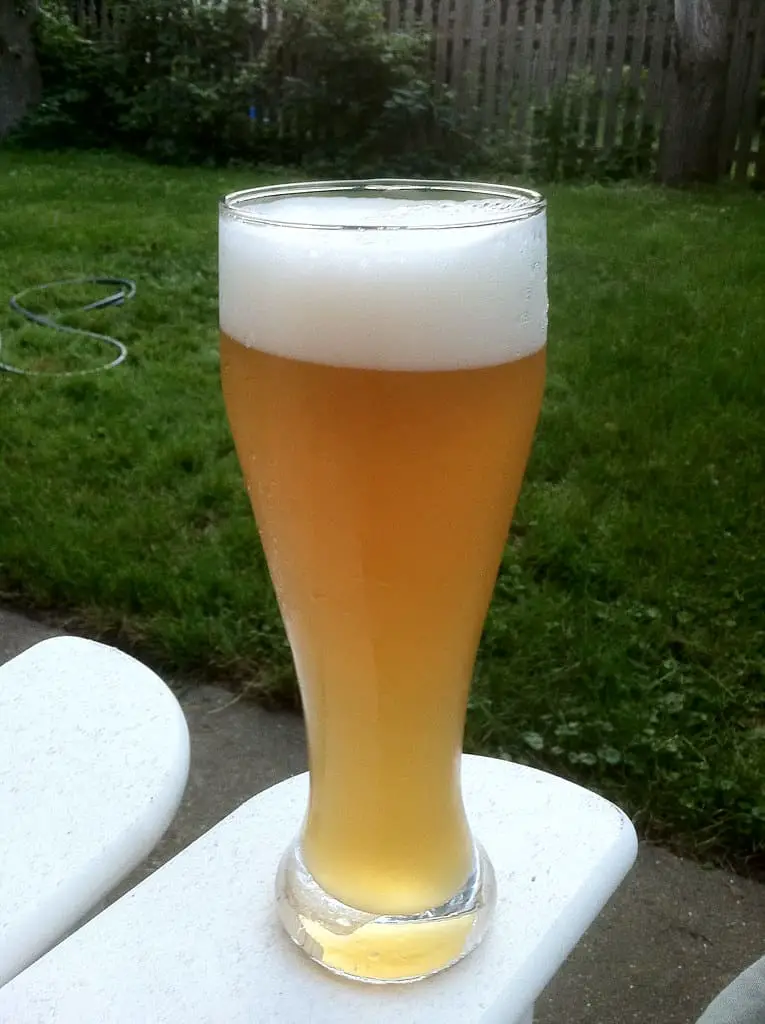For the most part, beer is brewed using barley malt because of the process’s ease. However, wheat beers have risen in popularity in recent times even though they are trickier to make.
Key Takeaways
- Hefeweizens are German-style wheat beers with banana and clove flavors, produced by specific yeast strains.
- Witbiers are Belgian-style wheat beers featuring a light, citrusy taste, spiced with coriander and orange peel.
- Both are unfiltered, cloudy beers, but Hefeweizens are more yeast-driven, while Witbiers emphasize using spices.
Hefeweizen vs Witbier
The difference between Hefeweizen and Witbier is that Hefeweizen is a German beer that is brewed by the fermentation of a Bavarian yeast strain known as Torulaspora delbrueckii whereas Witbier originated in Belgium and can be fermented using a variety of yeast strains such as Belgian Witbier, Forbidden Fruit or Belgian Wheat.

Hefeweizen is a traditional unfiltered Bavarian style of beer that is also called ‘Weizenbier’. A large amount of malted barley (at least 50%) in the concoction is replaced with malted wheat.
A strong hazy appearance makes this beer stand out among others. Nowadays, Witbier contains an interfusion of spices and citruses such as coriander, orange, or bitter orange.
Comparison Table
| Parameters of Comparison | Hefeweizen | Witbier |
|---|---|---|
| Origin | Hefeweizen originated in the state of Bavaria, Germany. | Witbier originated in Belgium but is also commonly brewed in the Netherlands. |
| Yeast Strain | It is fermented using a Bavarian yeast strain called Torulaspora delbrueckii. | It can be fermented using a variety of strains, including Belgian Witbier, Forbidden Fruit or Belgian Wheat. |
| Wheat Content | The wheat content in the beer is 50 per cent. | The wheat content in the beer is between 30 to 60 per cent. |
| Colour | The colour can vary from pale straw to dark gold. | The colour can vary from pale straw to light gold. |
| Clarity | Hefeweizen is relatively clear. | Witbier is very hazy and cloudy. |
| Flavour | It has overtones of banana, cloves, and even vanilla or bubblegum. | It has overtones of spices and citrus `such as coriander and orange. |
What is Hefeweizen?
Hefeweizen is a German beer that was first created in South Bavaria. It is brewed using top-fermenting yeast and contains at least 50% of malted wheat. The colour of the drink can be anywhere between pale straw and dark gold.
In earlier times, Hefeweizen was fermented using only a large proportion of wheat malt or air-dried barley malt. Hence, its name, which literally translates to ‘yeast wheat’ and refers to traditional unfiltered beer.
The beer has gained massive popularity due to its subtle bitterness and high carbonation. These characteristics tend to cut through the sweet malty taste of the wheat.
Renowned brands producing this drink in Germany include Paulaner, Maisel, Franziskaner and Erdinger. These are among the most popular names across the world.

What is Witbier?
Witbier is a Belgian beer that is characterized by its distinct hazy and cloudy appearance. Yeast and wheat proteins that are suspended during their production account for this.
In the 16th and 17th centuries, Witbier was immensely popular in Hoegaarden and Leuven. The drink was concocted using malted barley, unmalted barley and even a slight amount of oats.
This traditional production style was reinstituted recently by Hoegaarden Brewery and the Celis Brewery in the US. However, beer is nowadays made with a variety of spices and citrus, including coriander, orange, and bitter orange.
Some renowned brands of Witbier include Ritual, 50 West, Badger State, Funkwerks, Telegraph, Avery, and New Belgium Fat Tire.

Main Differences Between Hefeweizen and Witbier
- Hefeweizen is relatively clear in appearance, whereas Witbier is very hazy and cloudy.
- Hefeweizen has overtones of banana, clove, and vanilla or bubblegum, whereas Witbier has overtones of spices and citruses such as coriander and orange.


I had no clue Witbier was made using a variety of spices and citrus.
As a lover of weizenbier and witbier, I appreciate the differences between the two beer styles.
It’s interesting to know about the popular brands that produce both Hefeweizen and Witbier.
The production history of these beer styles is fascinating. Great article!
Wheat beers are amazing! I’m glad both styles of beers have gained popularity.
The comparison chart was extremely informative. Getting to know about the color and clarity of these beers was enlightening.
I wonder what is the process of production of these beers. Does anyone know?
I had no idea that a large amount of barley is replaced with malted wheat for Hefeweizen. Interesting!